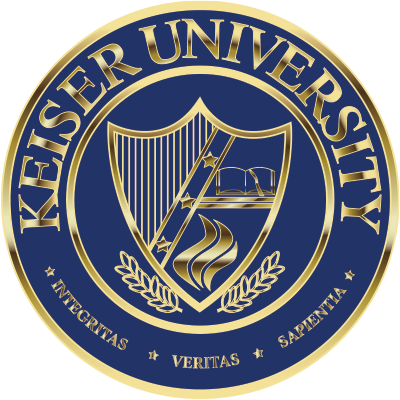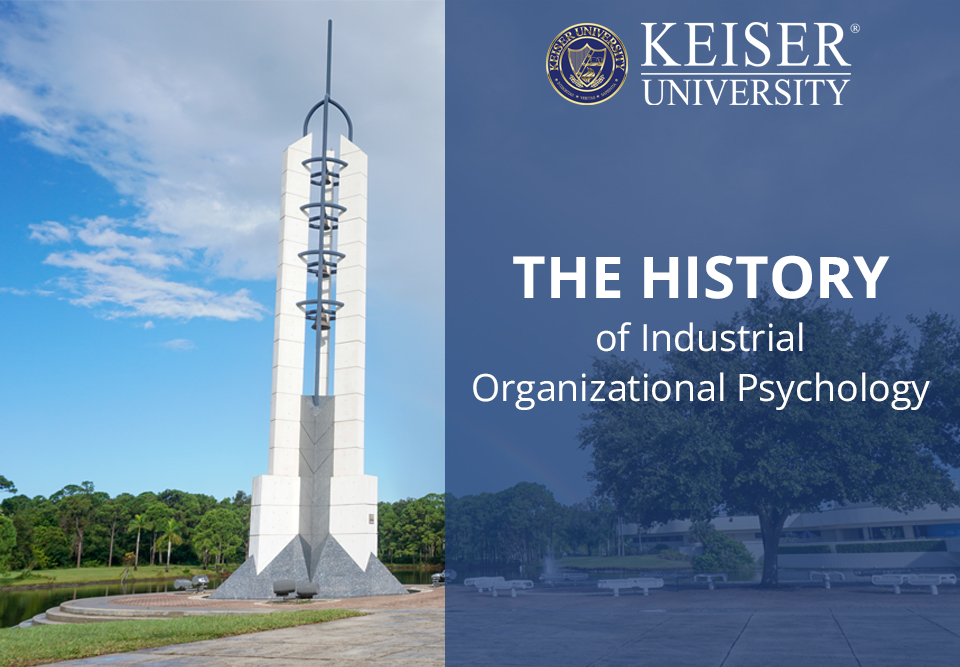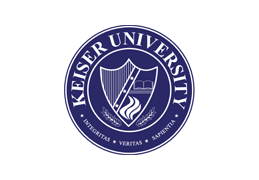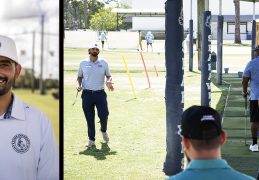Industrial organizational psychology is a fascinating practice that is increasingly receiving the considerable attention and respect it deserves. This impactful branch of psychology plays heavily into everything we take for granted in the modern workforce — and it could hold huge implications for the future of work. Keep reading to learn what I/O psychology is and how far it has come.
What Is I/O Psychology?
Industrial organizational (I/O) psychology is an important branch of psychological practice that emphasizes human behavior within a group setting. Specifically, this branch focuses on the application of psychological theories to the modern workplace.
Keiser University’s Dr. David Bracken puts it best. He explains that industrial organizational psychologists help “leaders, managers, and organizations make better decisions about people. We bring science to the study of human behavior in organizations.” The goal is to ensure that decisions impacting employee selection, training and management are made “based on science and not on a flip of a coin.”
History of I/O Psychology: A Basic Timeline
Historians often refer to psychology, with origins traced back to the mid and late 1800s, as a young science. Many point to Wilhelm Wundt and William James as the fathers of modern psychology.
The industrial organizational branch emerged a few decades after psychology itself. The experts of the time realized that psychological principles could be applied in a variety of settings, including the rapidly changing workforce of the early 20th century.
Below, we’ve highlighted some of history’s most exciting I/O developments, along with the inspiring professionals responsible for these breakthroughs.
Early History
I/O psychology has been around nearly as long as the overarching practice of experimental psychology. Fresh I/O concepts emerged during the early 1900s. In 1903, for example, William Lowe Bryan (an early organizer of the American Psychological Association) referenced the need for “real life” psychological practices.
Walter Dill Scott advanced this practice considerably by publishing two works in 1911: Influencing Men in Business and Increasing Human Efficiency in Business. He applied key psychological practices to concerns such as employee motivation. Walter Dill Scott was also highly interested in the role of psychology in advertising; he posited that most consumers would not act rationally, therefore enhancing the power of suggestibility.
Frederick Taylor contributed to early I/O discourse by applying more scientific rigor to business & management with his time-study methods that sought to quantify how much work could be done in a certain amount of time by workers. Soon after, Frank & Lilian Gilbreth pioneered motion studies which similarly sought to improve training & efficiency in employee processes by analyzing the exact motions made during a day’s work. Time-motion studies are the natural combination of these two techniques and are still used today.
In 1913, Hugo Munsterberg released the hugely influential Psychology and Industrial Efficiency, which laid the groundwork for what we now refer to as I/O psychology. His goal was to help organizations shape workers as needed to improve general workplace productivity.
Munsterberg prioritized finding “the best possible man” before discovering how “to produce the best possible work and how to secure the best possible effects.” In addition, Munsterberg hoped to shed light on a “new science… intermediate between the modern laboratory psychology and the problems of economics.” He published 20 books, largely on applied psychology, between 1906 and 1916.
(quotes taken from Munsterberg’s 1913 book Psychology and Industrial Efficiency)
World War I
As revolutionary theories from the likes of Munsterberg took shape, I/O psychology was poised to make a huge leap forward. The catalyst for this leap was World War I. There’s no denying the influence of the then-president of the APA, Robert Yerkes, who felt that psychology should be utilized to its fullest possibility to improve soldier selection, performance, and morale. To this end, he worked with the Surgeon General’s Office and Clarence Stone Yoakum to create screening methods such as the Army Alpha Test.
Early forms of I/O psychology also played a role in developing occupational classifications. This effort was spurred by the aforementioned Walter Dill Scott and Walter Bingham. They launched a useful job description system, plus skills tests for officers.
This era also marked the launch of the Journal of Applied Psychology, which remains an important I/O publication to this day. Research published in this journal would later have a huge impact on I/O psychology and many other applied practices. The journal’s founders hoped to make the then-new practice of psychology more compelling and palatable to the general public, largely by focusing key theories on the most relevant social issues of the day.
Hawthorne Studies
The Hawthorne Effect is one of the most widely discussed phenomena in I/O psychology and beyond. This term references a common scenario in psychological experiments: subjects change their behavior (typically working a lot harder) when they know that they’re being observed.
While we take this concept for granted today, it was a major discovery at the time. Until then, the earliest forms of I/O psychology primarily focused on the selection process. With the Hawthorne Studies, however, came a closer look at more complicated phenomena, such as supervisorial style and interpersonal relations.
Importantly, more recent work has revisited the Hawthorne Effect – proposing alternative explanations or criticizing the initial studies’ data collection and conclusions. For instance, the Novelty Effect of being observed or providing employees with feedback can also increase performance.
The famed Hawthorne Studies took place at the Western Electric’s Hawthorne Works Plant during the 1920s. Several esteemed professionals were involved in this effort, including psychologist Elton Mayo. The studies involved several separate experiments, including:
Illumination Experiment
The Hawthorne Studies kicked off with experiments designed to test the impact of lighting levels on worker performance. Researchers anticipated that greater illumination would boost productivity. In reality, however, performance only diminished when conditions akin to moonlight were reached. The final conclusion? The impact of lighting was negligible.
Relay Assembly Test
Conducted on a far smaller scale than its illumination predecessor, the relay assembly test was limited to just six women, who used small parts to create a telephone relay. Changes in rest periods and working hours were then assessed.
The participants made it clear that they preferred working in a small group without rigid supervision. Researchers were astonished by the workers’ improvements in mental attitude, as well as the benefits of working shorter hours.
Interview Program
During the Hawthorne Studies, researchers conducted tens of thousands of interviews with workers. Researchers were surprised by how frequently interviewees wanted to discuss their personal lives. The key takeaway from these interviews was that employees valued the communities they formed in the workplace. Mayo’s protege Fritz J. Roethlisberger was struck by their constant desire to create “informal relationships of interconnectedness.”
Bank Wiring Room
Meant to observe social structures within a large group, the bank wiring room experiment involved the setup of a test room, in which subjects were asked to wire conductor banks. A variety of incentives were used to influence their productivity, including both individual and group incentives.
Researchers were shocked when productivity actually decreased. This was attributed to the development of an informal group within the larger workplace group. This informal group used strategies such as social isolation to get members to reduce their output.
This research eventually led to the introduction of a large “nondirective” employee counseling program designed to sustain the benefits of the study. Eventually, 55 counselors were listening to the 21,000 employees until 1956 when the program was discontinued as new management took control.
World War II
If World War I hastened the development of I/O psychology, World War II represented its emergence into the mainstream. At this point, the selection procedures first advocated for during World War I had been refined, so they were highly sought after. The Army General Classification Test, for example, was used to place millions of soldiers. Likewise, the U.S. Office of Strategic Services (the precursor to the CIA) relied on I/O principles to reveal the best candidates to become high-level agents.
60s & 70s
Despite the Hawthorne Studies, the application of I/O psychology largely remained limited to selection processes prior to — and during — World War II. That quickly changed in the postwar era, however, as research began to focus on theories of motivation.
Carl Rogers’ belief in the human desire for self-actualization was highly influential, as was the iconic hierarchy of needs from Abraham Maslow. B.F. Skinner also played an important role in applying behaviorism to organizational concerns.
Management experts helped shape this era’s discourse on motivation. Management professor Douglas McGregor, for example, introduced the X and Y Theory, which revealed the importance of two distinct (and impactful) assumptions about employees: Theory X assumed that employees needed to be warned with punishment because they didn’t want to work, while Theory Y took the more positive view that, in a supportive environment, self-direction would boost employee achievements.
Additional motivation theories were proposed by Frederick Herzberg, David McClelland and Victor Vroom. By the 70s, research trends would transition to the role of bias in organizations, although B.F. Skinner continued to advocate for behavior modification strategies to increase motivation.
Concerns about test fairness were frequently brought up, forcing I/O psychologists to defend their findings. Still, the prominence of I/O psychology continued to increase, as evidenced by the initial publication of the Handbook of Industrial and Organizational Psychology in 1976.
During this decade, many prominent corporations turned to I/O experts for insight as they faced accusations of discrimination — and began to shift hiring and management practices to better align with Equal Employment Opportunity (EEO) requirements. As such, the focus of I/O psychology was not primarily on productivity anymore, but also, employee satisfaction, and retention.
Society for Industrial and Organizational Psychology (SIOP)
SIOP was formally incorporated in 1982 and remains the premier professional association for the science & practice of I/O psychology. It is affiliated with both the American Psychological Association (APA) and Association for Psychological Science (APS).
While the current name is relatively new, SIOP traces its history back through Division 14 in the 1940s all the way to a number of industrial psychologists being prominent members of the APA during its founding in 1892.
Today, SIOP has over 9000 members and provides a wealth of information and resources for those already in or interested in this exciting and evolving field.
Information Age
The Information Age brought about exciting opportunities but also challenged much of what management and I/O psychology experts had come to take for granted about workplace relations and employee motivation. As such, the 1980s saw a shift towards participatory management, which aimed to improve commitment among personnel. Research during the 90s examined the role of stress on performance and the need for work-life balance.
Underscoring these shifts were rapid advances in technology, which influenced our perception of a previously stable concept: what, exactly, constitutes a “job.” I/O experts began to express a greater interest in the link between leadership and innovation, as well as the need for adaptability in a quickly changing work environment.
Present & Future
I/O psychology has come a long way in just a few years, but the pace of change isn’t about to slow down. If anything, all signs point to accelerating developments as new research and exciting technologies become available.
Currently, automation and big data are huge areas of concern. As artificial intelligence plays into a wider variety of workplace functions, relationships will need to be examined not only between workers and management, but also, between human employees and their automated counterparts.
Additional tech-oriented concerns have been brought to light by COVID. In response to initial lockdowns, work from home setups took over. Hybrid work continues to be a clear preference for most employees, who spend far less time in the office than they did pre-pandemic. As a result, new strategies are needed to boost intrinsic motivation while establishing stronger connections between professionals. Research initiatives will delve into the phenomena of quiet quitting and the Great Resignation, hopefully providing insights that will improve employee satisfaction and retention far into the future.
Industrial and Organizational Psychology Student Testimonials
Dr. Andrea Swink

Dr. Kali G. Hite

Dr. Amber Petrie

Dr. Samuel Mercado’s Journey: From MBA to Doctorate in Industrial and Organizational Psychology

Interested? Explore I/O Psychology at Keiser
A career in I/O psychology gives you a powerful opportunity to shape the workforce of tomorrow. If you’re interested in entering this exciting field, you’ll first need to enroll in a respected graduate program. Upon graduation, you’ll enjoy access to a wide range of compelling career opportunities.
At Keiser University, we’re pleased to provide exceptional training via the Master of Science in Industrial and Organizational Psychology and the Doctor of Philosophy in Industrial/Organizational Psychology. If you’re ready to take the next step, feel free to get in touch.






 The instructors at Keiser University impacted my life. They believed in my ability to become a great graphic designer, regardless of how I felt about my skills. KU helped to prepare me for the real world and got me to where I am today.
The instructors at Keiser University impacted my life. They believed in my ability to become a great graphic designer, regardless of how I felt about my skills. KU helped to prepare me for the real world and got me to where I am today.
